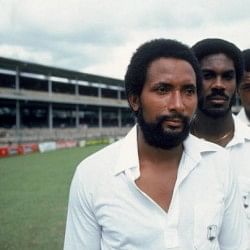
The golden age of variety

West Indian fast bowlers (left to right) Andy Roberts, Michael Holding, Colin Croft and Joel Garner, February 1981.
Apologies in advance to those who came across this piece on the web and expect to find a discussion on the London Palladium and Batley Variety Club…
There’s been some very good and interesting discussion on these pages in recent days on the merits of playing four seam bowlers instead of a more balanced attack.
I don’t think there were many times in the evolution of the game, prior to the West Indies XI of Clive Lloyd, where it happened. More often there would be two opening bowlers, a first change and then a couple of spinners. Sometimes a batsman might double as a fourth seamer (like Ted Dexter, Walter Hammond) or as a spinner (Bobby Simpson, Collie Smith). Most sides had an off-spinner, and slow left arm spin bowlers were common. Before 1960′s, there were plenty of leg-spinners. Blessed were the sides, like Derbyshire, where Derek Morgan bowled seam and then switched to off-cutters as the ball got older.
That’s the thing the current Derbyshire side lacks. Ross Whiteley suggested he might become a genuine all-rounder before leaving, while both Tim Groenewald and Tony Palladino offer good lower order runs without yet being able to call themselves genuine all-rounders (though it may yet come for both of them).
I understood the rationale of four seamers with the West Indies. They could play four quick bowlers and effectively bowl them all day. Each was sufficiently different to keep the batsman guessing. Roberts was fast and skiddy, Marshall fast with swing, Holding fast and nipped it around, Garner fast with steepling bounce, and Croft was fast and bowled from awkward angles. I could go on, but all of them challenged the batsmen with raw pace and the fact that there was something different going on made it possible. Then Viv Richards had a few overs and took wickets as everyone relaxed for a while.
That is why Mark Footitt is so important to our side, as the number of bowlers who bowl genuinely fast left arm, now or over the game’s history, could be counted on the fingers of one hand. Mark can lose his line occasionally, but most bowlers can do that and his strike rate is as impressive as his more recent fitness record.
Groenewald and Palladino are proven county bowlers of quality (250 wickets does that for a man), and, at present, they would always be in my side. They usually take wickets; if they don’t, they are tidy and make batsmen work. That’s before you consider their contributions with the bat, which can neither be underestimated or undervalued.
Mark Turner? I think Mark is a lovely lad, and he gives one hundred percent in everything he does. When he lets the ball go, it appears to be with every ounce of strength he has. In the field, he has good hands and dives around with the best of them. He bowled well and with success in the pre-season game against Warwickshire, but he has taken only one wicket for 230 runs in two championship matches so far. In those same matches, Wes Durston has six wickets for 195 runs, while David Wainwright took 2-84 – and scored valuable runs – at Chelmsford.
Never having faced them, I’m unsure how different our three right-arm seam bowlers are in pace. From the boundary edge, it would appear that Turner is quickest, though the more erratic. I’d just like to see more variety in the attack, as unless you’re talking express pace – and we’re not – county batsmen must find them all fairly similar. On a helpful track that is no hindrance, but, when the wicket isn’t doing that much, variety and keeping people on their toes is the key to success.
I take on board Marc’s point (below the last article) about a seamer getting injured during a match, but how often does that really happen? If there are pre-match doubts over the fitness of one, you play someone else. By extension, you don’t pick seven batsmen, on the off chance that one breaks a finger taking a slip catch.
This is where, for me, opportunity could come for young tyros in the weeks ahead. Alex Hughes, the best known, bowls skiddy medium pace, similar to Phil Russell of another era. He also bats well and offers genuine all-round potential, as well as, crucially, something different. So too does Greg Cork, who has the added bonus of being a left-arm seamer. I think Cork junior has some filling out to do, but the potential is vast. Speaking of which, there’s also Ben Cotton, who’s height offers variety, bringing the ball down from a different angle. Nor should we ignore the potential claims of Tommy Taylor, who bowled beautifully against a strong Swarkestone side for Ticknall last weekend, and, as well as gaining movement with the ball, he has the prize asset, with all of the above, of novelty value. How do you play someone you’ve never seen before?
Graeme Welch will be watching his players and assessing their medium and long term roles in the club. He has already gone on record regarding the seam bowling talent in the club’s academy. For the weekend game at Worcester, I wouldn’t be surprised to seeing a change in either the thinking or personnel.